 It’s hard for me to explain Anita’s love of cycling. She genuinely enjoys the toughest inclines and the worst weather. She’s been doing sport cycling for all of a year, but she already looks at a windy, drizzling sky, and says, “I’m in the mood for a ride!”
It’s hard for me to explain Anita’s love of cycling. She genuinely enjoys the toughest inclines and the worst weather. She’s been doing sport cycling for all of a year, but she already looks at a windy, drizzling sky, and says, “I’m in the mood for a ride!”
I consider myself, perhaps unfairly, to be more normal. I like the sensation of speed and control from a well-tuned road bike on a straightaway or a downhill — preferably on a sunny day. I get a thrill from rushing down narrow trails in a forest. I enjoy the way that a bike takes me through neighborhoods and landscapes at an ideal speed: fast enough to keep my attention from wandering, but slow enough to actually see and feel the environment. Uphills are a necessary part of it, and I typically don’t get much more from them than the sense of accomplishment that I get from a freshly-vacuumed room or finishing my errands for the day.
Friday, May 16 was a sunny day, as you can see from the following photo of our start. So let’s call that a compromise and get riding!

Can you spot the stowaway in this photo? Click on the image for a larger version.
The hills are all outside Oudenaarde, roughly to the south of the city. So we started on a fairly nice bike path along the Scheldt — and a tailwind!
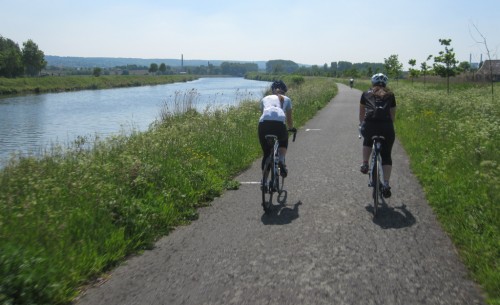
We designed a route that would take us to the Oude Kwaremont first.

The Oude Kwaremont was the only cobbled climb that both Anita and I attempted in January. After the blistering pace set by the group then, we “blew up” within the first one hundred meters of cobbles, labeled “Kasseien” in the profile below.
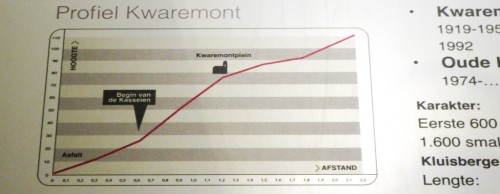
A famous synonym for “Kasseien” is “Kinderkopjes” which literally translates to “children’s heads” and refers to the distinctive size of these paving stones. The challenge is not so much the stones themselves as the gaps between them.
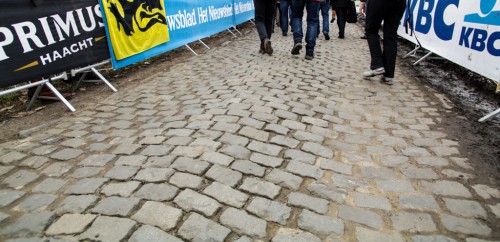
You bump from each wide gap, up onto the top of each stone. This makes the 11% incline feel like… well, it’s hard to describe. It’s not as if it simply adds 5% to the incline, like riding up a smooth 16% hill.
When you’re strong, early in the climb, you feel like your bike is shaking a lot, and that there’s a risk of it slipping from beneath you. Not so bad. When you slow to a crawl, legs burning, each cobble becomes a little obstacle, as your front wheel falls into each gap and seems to stick there, until you muster an inhuman effort, pushing against the pedals to thrust the whole bike forward. Then you coast for six inches of uphill progress before your front wheel lodges itself into the earth again.
Once in while, you find two or three cobbles close together, and pedaling becomes a sane thing to do for a second or two. It feels amazing, and your eyes dart all over the road to find another pair. Meanwhile, your front wheel dives into the dirt again, and you hear the metal of your rims scrape, incredibly, with your tire inches deep in another rut.
Anita set one goal for herself – to climb to the Kwaremontplein without stopping. We arrived at the bottom of the hill with warm legs and fresh lungs. There wasn’t a strong cross-wind or head-wind.
My change from bike-shaking cobbles to Sisyphean stumbling blocks came early. Anita kept her speed and disappeared around a bend. Fortunately, the Oude Kwaremont is long rather than thigh-burningly steep, and I just kept turning over the pedals, less than one revolution per second.
I arrived a minute behind Anita, but it didn’t matter. We’d both come to the Kwaremontplein without falling, stalling, or giving up, we celebrated. Anita sent text messages, I smiled wide like a fool, and Rachel seemed pretty pleased as well.



The great riders all say that the thing, with cobbles, is to keep your speed. I can confirm the truth of that statement — and just how irrelevant it is to those of us with normal human legs.
It was simply impossible to keep my speed on the next climb, the steepest of them all, the Paterberg.
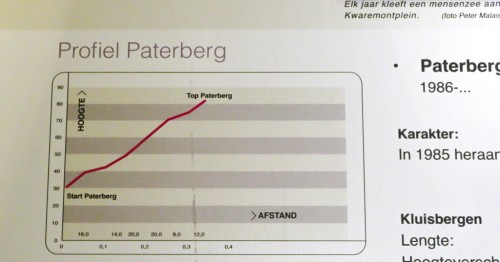
The route from Kwaremont to the Paterberg follows short and pleasantly winding roads. The long views give you a sense that you really did just climb a significant amount above the flatlands near the Scheldt.
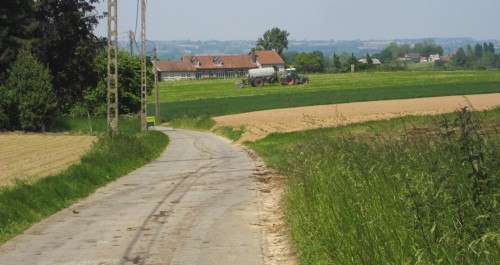
After a great little twisting downhill, you turn sharply right… and see a wall.
The Paterberg is literally twice as steep as the Oude Kwaremont. Its average gradient is steeper than the maximum gradient of the
 Oude Kwaremont. It’s very short, but that doesn’t make much difference when the cobbles are rabbit-punching you backwards. Here’s Anita’s assessment:
Oude Kwaremont. It’s very short, but that doesn’t make much difference when the cobbles are rabbit-punching you backwards. Here’s Anita’s assessment:
This hill is insane. I knew it was insane from January and May did nothing to change my mind. I’d like to say I rode the first 150m, but I actually have no idea. It was this hill that I realized that Rachel was just in a different league, even though she has been mostly off the bike for nearly a year.
I decided within 50 meters that I’d found a good place to stop and take some photos. Anita and Rachel struggled forward and I was happy to document their progress.
Walking up the Paterberg, even in mountain-bike shoes that have some traction, was very slow going. But at least, for me, walking was physically possible. Anita stayed on her bike a lot longer…
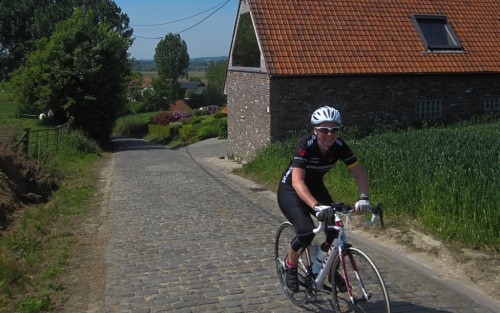
But she succumbed when the incline became ludicrous.
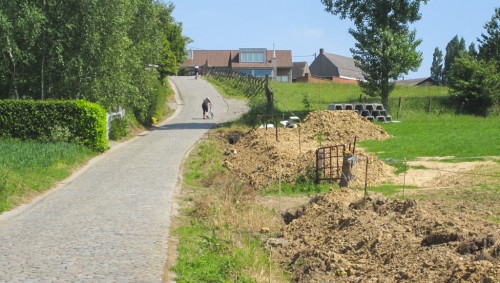
I took a few photos of the steepest part, where the fencing might convey just how close this gets to unwalkable, let alone unrideable.
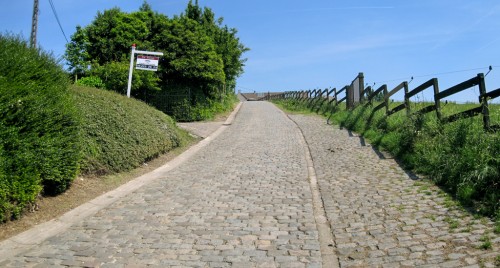
We were proud of Rachel for having cycled the whole hill. There are pros who have dismounted on this hill out of sheer exhaustion. While Rachel waited for us, she could appreciate one of the best views of the ride.

I would like to return to this course again, in better shape, and test myself. I would like to believe that I will be able to tackle every hill from this ride, someday. The Paterberg, though… the Paterberg gives me doubts.
For Anita, everything from this point forward was new. I would cover the same hills I’d seen in January — but with the luxury of knowing where I was and a little bit better fitness.
We cycled up and down along paved roads for a time, weaving to the next famous climb. The roads in Belgium have more creases and potholes than those in Luxembourg, but the fields were pretty and there were very few cars. Despite being a workday, there were groups of Citroën 2CVs puttering around the back roads, full of passengers shouting greetings and smiling back at us.
The Koppenberg is recognizable as the most sunken of the roads on the course; the trees and brush crowd the cobbles, leaving no room to cheat along the side. In the pro race, it’s the only part of the course without spectators pushing forward.
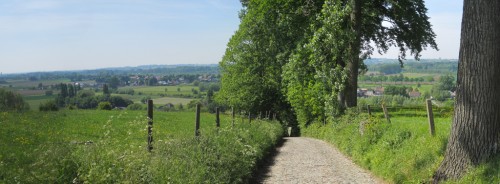
Anita and I climbed the Koppenberg one cobble at a time. We started slowly, making way for a Citroën that wanted to test its little engine.

One surprise was that my arms were getting worn out before my legs. Due to the pattern of the cobbles, my front wheel often wanted to twist 90 degrees, as if my handlebars were trying to throw me off the bike. When I let myself stop completely, I needed to lift the front end of the bike up, onto the next cobble, and then mash down on the pedals to get over it.

Anita and I both made it into the shaded, wooded part of climb and then could not turn the pedals one more time. We dismounted, slipping on the damp stones.
“This is about the same point where I had to get off in January,” I gasped, as I caught my breath. We walked a few dozen meters before Anita suggested that we get back on the bikes and try to finish strong.
If you have clipless pedals on your bike, then you know how tough it can be to start on an incline (and with those cobbly ruts as well). If you’ve never had clipless pedals, it will be hard to imagine the combination of balance and strength that you need to clip in and start pedaling, up hill. With legs still burning, it took us a few tries, and I was sorely tempted to give up.
Knowing that Rachel was waiting at the top to see how well we did — that was just enough motivation to get back on the bike and stay on it. Otherwise, I think that Anita and I might have snapped some photos and left the Koppenberg for another day.

My legs and lungs were burning, and I wheezed like I needed medical attention, but I got to the top without dismounting again. I declared victory and then asked the ladies whether we could rest on the verge for a little while.
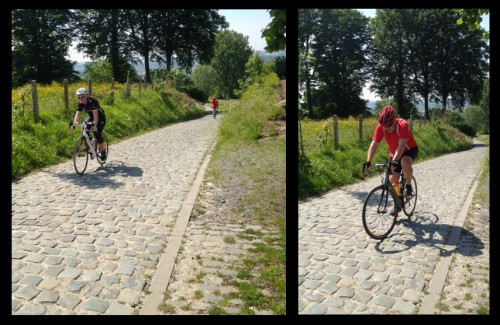
We’re halfway done and the most fun is yet to come!
5 Comments to “Return to Flanders: Part 2”
29 May 2014
Thank you for taking the time to explain the ride in detail. I really feel like I was there. And that I need to get on the bike more to get in better riding shape.
29 May 2014
Another good read. And thanks for the nice words about my cycling. Can’t wait to read part 3!
12 June 2014
I think I’m somewhat of a cross between you and Anita. I want to experience these climbs with you, but I also like a sunny day. I guess I’m a cat, I don’t like water.
I can’t imagine what your arms feel like after all those cobbles!
15 June 2014
Ok, so on my ride this morning, the top layer of asphalt was torn off about a mile stretch of road. The under layer was the really bumpy layer which caused my arms to vibrate like crazy. I made a “it’s the Tour of Flanders” joke.
Trackbacks & Pingbacks
Return to Flanders, Part 3 · Bakker Bugle Blog
Pingback on July 3rd, 2014 at 20:22